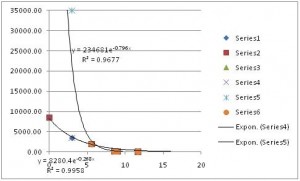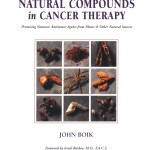Esophageal Cancer is a terrible disease that has an extremely high mortality rate. It often occurs as a progression from Barrett’s Esophagitis, which is believed to be caused by repeated exposure of the esophagus (the ‘tube’ that transports what you eat to your stomach) to stomach acid – aka acid reflux.
There are numerous studies that have indicated that chronic use of aspirin and some NSAIDs can significantly reduce the risk of Barrett’s Esophagitis progressing to Esphogeal Cancer.
The mechanisms behind this abilty to stop or slow the progression of inflammed tissues of the Esophagus to cancerous conditions appear to be the same as those behind the reduction of cancer risks at other sites when aspirin is taken on a continuous basis.
We’ve talked about this before. I won’t belabor the point or the mechanisms. Instead, I’m going to post excerpts from a couple of journal articles that I think summarize the situation best.
The first article is titled ‘NSAIDs Modulate CDKN2a, TP53, and DNA Content Risk for Progression to Esophageal Adenocarcinoma’. It was written by Galipeau PC, Li X, Blount PL, Maley CC, Sanchez CA, Odze RD, Ayub K, Rabinovitch PS, Vaughn TL and Reid BJ – and it was published in 2007 in the journal PLoS Medicine (February 2007, Volume 4, Issue 2, e67 – pp 0342-0354).
You can get a free copy of it at http://www.plosmedicine.org/article/info:doi/10.1371/journal.pmed.0040067 .
In the abstract for this article the authors say ‘In patients with zero, one, two, or three baseline panel abnormalities, there was a significant trend toward EA risk reduction among NSAID users compared to nonusers (p=0.01) The strongest protective effect was seen in participants with multiple genetic abnormalities, with NSAID nonusers having an observed 10-y EA risk of 79%, compared to 30% for NSAIDS users (p < 0.001)’. They close their abstract by saying ‘A combination of 17p LOH, 9p LOH, and DNA content abnormalities provided better EA risk prediction than any single TP53m CDKN2A, or DNA content lesion alone. NSAIDs are associated with reduced EA risk, especially in patients with multiple high-risk molecular abnormalities.’ In the editor’s summary for this article they say ‘Overall, just 12% of patients with no abnormalities but nearly 80% of patients with three abnormalities developed esophageal cancer. NSAID risk reduced the risk of cancer in all of the participants, but its effect was greatest in those with three genetic abnormalities.’
So – what the heck did they say? Well, EA is their abbreviation for Esophageal Cancer. Progression from normal esophageal cells to cancer cells appears to follow a path of repeated mutation as a result of chronic irritation caused by repeated exposure to stomach acid. The genetic mutations and characteristics they identified in this study seem to be very highly associated with the final progression of Barrett’s Esophagitis to cancer. Aspirin and NSAID use appears to cause a reduction in the progression of Barrett’s Esophagitis cells to cancer, and the higher the number of mutations that are observed in a person’s cells the higher the protective effect of aspirin and NSAIDs.
The second article is titled ‘Non-steroidal anti-inflammatory drugs and risk of neoplatic progression in Barrett’s oesophagus: a prospective study’, and it was published in the journal Lancet Oncology in November of 2005. (Lancet Oncology, 2005; 6:945-952). The authors were Vaughn TL, Dong LM, Blount PL, Ayub K, Odze RD, Sanchez CA, Rabinovitch PS and Reid BJ. (Yes – I know – these authors contributed to the other article also.)
You can get a copy of this article – but it will cost you unless you can get access to it through your library’s reference librarian, or at a major university’s library – or maybe even through a major hospital’s medical library. Look for a ‘teaching’ hospital, they usually have good online access.
Anyway, in closing their discussion of the findings for this study the authors said ‘Our findings lend support to previous observational studies and animal studies, in that use of aspirin and other NSAIDs might protect against development of oesophageal adenocarcinoma in NSAID users; the incidence of oesophageal adenocarcinoma for former users approached that of never users about 36 months after baseline assessment. People with high-grade dysplasia who reported current NSAID use had a lower risk of neoplastic progression than did those with high grade dysplasia who reported former or never use of NSAID, suggesting that NSAID use might be an effective intervention even at late stages of neoplastic progression.’
Translation: If you have Barrett’s Esophagitis aspirin and NSAIDs reduce your risk of having the cells of the esophagus turn cancerous – even in cases where the cells are really screwed up. So, it might be possible to reduce the progression to cancer in even very severe cases with aspirin or NSAIDs.
To make sure you know I am looking at the studies that don’t support my belief in aspirin and NSAIDs and their ability to prevent or slow the progression of cancer I am also posting the link to a journal article that disagrees with the idea that aspirin can change the rate of progression of Barrett’s Esophagitis to cancer. I haven’t been able to get a copy of the article yet… but I will the next time I’m at the library.
‘Aspirin is not chemoprotective for Barrett’s Adenocarcinoma of the oesophagus in multicentre cohort’ http://journals.lww.com/eurjcancerprev/Abstract/2009/09000/Aspirin_is_not_chemoprotective_for_Barrett_s.7.aspx
That said… I’m going to keep taking my regular strength aspirin every day till this argument gets sorted out.
You know the drill by now… I’m a Pharmacist, not a physician. You MUST talk to your physician and get his/her guidance before changing your medication regimen or adding aspirin or NSAIDs to your daily routine. Remember, Pharmacist Pharmacist – Doctors Doctor. As it should be.
![CA125StressSlopesMitchell[1]](https://thatcrazypharmacist.com/wp-content/uploads/2010/06/CA125StressSlopesMitchell14-300x286.jpg)

